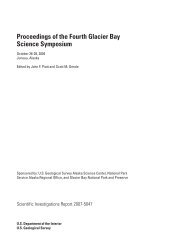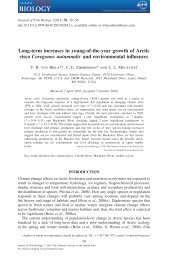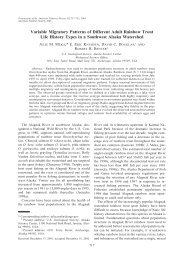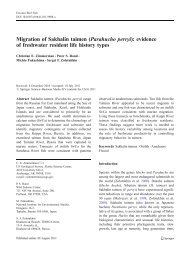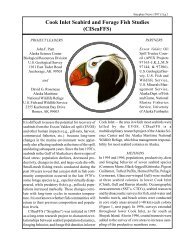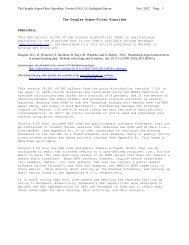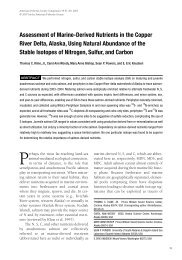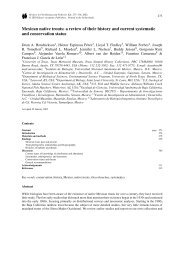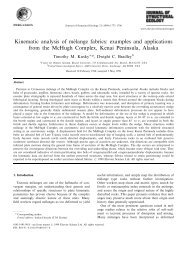UNCORRECTED PAGE PROOFS - USGS Alaska Science Center
UNCORRECTED PAGE PROOFS - USGS Alaska Science Center
UNCORRECTED PAGE PROOFS - USGS Alaska Science Center
You also want an ePaper? Increase the reach of your titles
YUMPU automatically turns print PDFs into web optimized ePapers that Google loves.
spe371-01 page 21 of 31<br />
Geologic signature of early Tertiary ridge subduction in <strong>Alaska</strong> 21<br />
of andesite ßows dated at 65 Ma near the base, which toward<br />
the top are interbedded with rhyolite domes and basalt ßows,<br />
and intruded by 56 Ma granodiorite. The upper part of the<br />
Blackburn Hills succession shows a change from calc-alkalic<br />
(“arc-type”) to mildly alkalic (“post-arc-type”) compositions<br />
ca. 56 Ma (Moll-Stalcup, 1994).<br />
Uplift of the Brooks Range and North Slope<br />
Apatite Þssion track studies reveal that 1000 km inboard<br />
of the trench, the Brooks Range and the North Slope foreland<br />
basin (Fig. 1) were exhumed during Paleocene time (OʼSullivan<br />
et al., 1997). Rocks in the central Brooks Range cooled rapidly<br />
through 110–50 °C during discrete episodes at ca. 100 ± 5, ca.<br />
60 ± 4, and ca. 24 ± 3 Ma. Foreland-basin strata just to the north<br />
record cooling pulses at ca. 60 ± 4, 46 ± 3, 35 ± 2, and ca. 24 ± 3<br />
Ma. The 60 Ma event came after 40 million years of quiescence<br />
that had followed after collision-related Brookian shortening,<br />
and is notable because both the orogen and its proximal foreland<br />
were affected—a pairing that requires a mechanism other<br />
than thrust loading.<br />
EARLY TERTIARY TECTONIC MODELS FOR ALASKA<br />
We are now in a position to more thoroughly consider the<br />
various tectonic scenarios mentioned in the Introduction. Any<br />
viable model will need to account for the full range of coeval<br />
early Tertiary events in the accretionary prism: near-trench<br />
magmatism; low-pressure, high-temperature metamorphism;<br />
brittle and ductile deformation; ophiolite genesis; and trench<br />
sedimentation. Events in the <strong>Alaska</strong>n interior are less constraining<br />
for tectonic models because they can only be loosely tied to<br />
events along the coast; a successful tectonic model nonetheless<br />
should account for these events, at least qualitatively.<br />
Eight possible explanations for near-trench magmatism—<br />
all involving subduction along the Gulf of <strong>Alaska</strong> margin—are<br />
explored below. The Þnal three are variants of each other.<br />
Arc magmatism. Kienle and Turner (1976) interpreted the<br />
near-trench plutons as the roots of an arc that had migrated to an<br />
extreme near-trench position. Even if the near-trench location<br />
might be explained in terms of very steep subduction, the arc<br />
model does not account for the diachronous age trend, nor for a<br />
coeval magmatic belt ~200–300 km farther inland along what<br />
had been the arc axis in latest Cretaceous time (Wallace and<br />
Engebretson, 1984). For a brief time, the seaward and landward<br />
belts coexisted, then magmatism tapered off in both.<br />
Spontaneous melting of flysch. Hudson et al. (1979)<br />
regarded the Sanak-Baranof granitoids as anatectic melts of<br />
recently accreted trench sediments. At best, this is only a partial<br />
explanation, because the gabbroic plutons and basaltic dikes<br />
of the Sanak-Baranof belt—volumetrically minor though they<br />
are—require a mantle source. Moreover, spontaneous neartrench<br />
melting is not happening at any of the thickly sedimented<br />
Neogene accretionary prisms of the modern world (e.g., Makran,<br />
Cascadia, Barbados). The spontaneous anatectic melting model<br />
also fails to account for the fact that the latest Cretaceous ßysch<br />
is the same age along the 2200 km length of the belt, yet there is<br />
a ten million–year difference between magmatism at the either<br />
end of the belt. Finally, this model provides no driving mechanism<br />
for deformation of the accretionary prism.<br />
Trench-hotspot encounter. Another possible cause of<br />
near-trench magmatism is overriding a sea-ßoor hot spot. Two<br />
lines of evidence argue against this model. The Þrst involves<br />
the age and location of magmatism. Overriding a hotspot<br />
would be expected to cause magmatism in only one place in<br />
an accretionary prism, not along its entire length. Only in the<br />
contrived case where the trend of the subduction zone was parallel<br />
to the relative motion of the overriding plate in a hot-spot<br />
reference frame would near-trench magmatism be diachronous<br />
along strike. Second, the distinctive alkalic signature of hotspot<br />
magmas are lacking.<br />
Slab breakoff. This idea would entail the failure of what<br />
had been a single, subducting oceanic plate. The more deeply<br />
subducted part of the plate would have broken away and<br />
descended into the deep mantle, leaving, in its wake, a slab<br />
window. Slab breakoff has been suggested in a number of<br />
collisional orogens—the result of jamming a subduction zone<br />
with buoyant lithosphere—but to our knowledge has not been<br />
demonstrated for any oceanic subduction zones.<br />
Flexural extension of a subducting plate. Tysdal et al.<br />
(1977) suggested that the Resurrection and Knight Island ophiolites<br />
formed by a variant of seaßoor spreading when a single<br />
subducting plate was ßexed upon entering a trench. Flexural<br />
extension, however, only effects the upper crust of a bending<br />
plate, so a clear mechanism for partial melting of the mantle<br />
would have been lacking.<br />
Ridge subduction. Subduction of an active ridge-transform<br />
system, our preferred model, provides a single, unifying explanation<br />
for near-trench magmatism, low-pressure metamorphism,<br />
deformation, and hydrothermal activity, geology of the ophiolites,<br />
and the history of trench sedimentation and volcanism.<br />
Subduction of very young seafloor. Melting of the accretionary<br />
prism might perhaps have been a consequence of subduction<br />
of very young ocean ßoor, but here the distinction blurs<br />
with the ridge subduction model, because very young ocean<br />
ßoor implies the nearby presence of even younger (zero-age)<br />
ocean ßoor at a spreading ridge.<br />
Subduction of a “leaky transform.” This mechanism, proposed<br />
by Tysdal et al. (1977) to explain the Resurrection and<br />
Knight Island ophiolites, also is merely a variant on the ridge<br />
subduction model because all spreading ridges have transform<br />
offsets and fracture-zone extensions.<br />
<strong>UNCORRECTED</strong> <strong>PAGE</strong> <strong>PROOFS</strong><br />
RIDGE SUBDUCTION / SLAB WINDOW MODEL<br />
On a global mosaic of two dozen large and small plates,<br />
divergent and convergent plate boundaries inevitably will<br />
intersect. The term “ridge subduction” describes the entry of a




